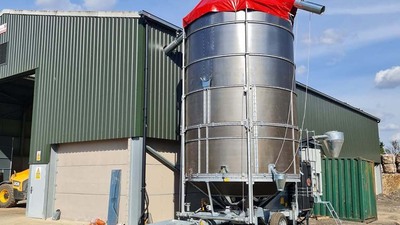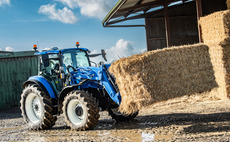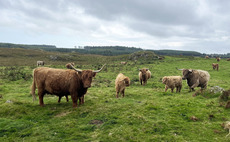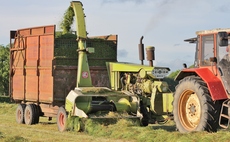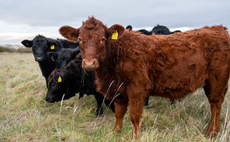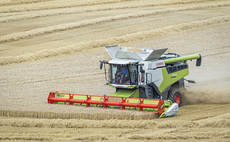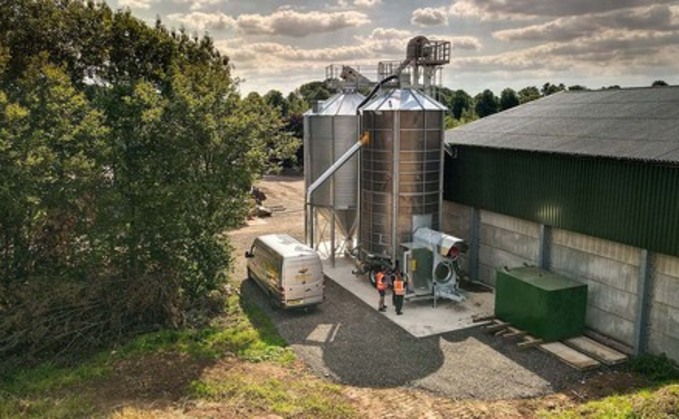
Many grain dryers have lain idle this year, but not everyone enjoyed a sub-15% harvest – and the next wet summer may not be far away. With fuel prices looking unlikely to fall far, Martin Rickatson seeks advice from manufacturers on maximising efficiency from mobile units.
It may seem a statement of the obvious, but no two years – and no two harvests – are the same. While harvest 2022 may have seen many grain dryers unused, it’s not so long since the last wet summer, and there is no guarantee they will not be needed in twelve months’ time. However you dry your grain, it’s unlikely the fuel and power your system needs will come down in price by any great extent. So what can you do to ensure every litre of fuel and kilowatt of electricity is used to best effect, and your mobile dryer does its job as efficiently as possible?
Ìý
Master Farm ServicesÌý
Ìý
“Whether youÂ’re investing in a new dryer or seeking to improve the performance of an existing one, investigating how it can be made to operate at maximum efficiency is a worthwhile use of time and money even after an easy, dry harvest,” suggests Garry Ingram, director at Master Farm Services, which sells and supports Pedrotti-made Master Driers.Ìý
Ìý
“Before considering the fuel and energy efficiency of the dryer itself, think how you can minimise use of fuel to load and unload it, and whether improving the surrounding infrastructure could help boost efficiency. Beyond fuel and energy, labour is obviously the other input that’s costly, but dryer automation can help minimise requirements.
“Positioning, particularly for dryers installed semi-permanently, is critical to minimising handling, keeping down handler fuel use and labour requirements and maximising efficiency. Existing buildings and equipment may influence your drying layout, but a new season and/or a new dryer represents a good opportunity to re-examine arrangements. Beyond standard models, it’s possible to customise machine size and layout to meet individual requirements. If considering a new dryer, a manufacturer should be able to create a model to suit your required working height, and – with features such as specific side-loading or extended loading auger and unloading auger position and type – to minimise handling.”
Ìý
Whether considering a tractor-driven machine or a fully automatic version, or already running a mobile dryer, (re)planning how you will fill and unload the machine, and perhaps investing in additional features for your dryer and drying system, can save significant time and money throughout the life of the machine, suggests Mr Ingram.
“From looking at a new-build store to exploring options for incorporating a batch dryer in a more user-friendly way, these might include anything from a two-tonne bucket fill hopper to go over the intake, to a complete system with trench intakes and store filling conveyors. When dealing with grain that requires drying off the combine, keeping it shifting is essential.
Ìý
“Consider also how supplementing your dryer with a generator set via the dryer company can make things simpler and more efficient. A set supplied with the correct plugs and breakers can be wired in by the supplier so that the dryer shuts down automatically when its work is done, saving fuel and labour.”
As a yardstick against which to measure a dryerÂ’s efficiency, a 25t batch dryer will use approximately 1.0 litre of fuel per tonne for each moisture per cent it is required to remove, says Mr Ingram.
“It’s therefore relatively easy to extrapolate this for the tonnages you need to handle and the typical moisture levels you ordinarily have to dry down from.”
Ìý
The majority of dryers sold today by Master Farm are electrically-powered, with customers seeking to utilise farm three-phase phase supplies, or power their machine via a generator.
“Electric drive now accounts for 95% of our retailed dryers, with a significant shift over the past 20 years from PTO units. However, there’s a still a market for £10-20k refurbished PTO machines on smaller farms.”
He reminds users to factor in electricity charges when calculating total running costs, noting that power price rises have mirrored those of fuels.
“Overall operating cost will depend on electricity tariffs as well as fuel cost, but an efficient drying system should be able to dry cereals at £1.50-2/t per percentage of moisture.”
Ìý
Mr Ingram advises that the person who is to operate the dryer, as well as the person buying it, takes part in the supplierÂ’s on-farm installation process, as well as any later consultation on operating issues.
“That will ensure all parties know how to operate the machine to best effect. It’s easy to forget how to best operate a machine that isn’t used for much of the year, and ideally it’s best to look at dryer set-up up well in advance of harvest. Use the manual and your supplier’s advice to understand the different settings, nozzles, cleaner screens and temperatures required for different crops, moistures and ambient conditions.
“The same goes for annual servicing – at the end of the process it’s worth going through with the engineer what has been done and any further operating tips. We’ve sold nearly 4,000 dryers in 42 years but are asked to service only around 250 annually – many owners will either try and service their machine themselves, or assume everything will be OK the next time it’s used. A pre harvest burner service and drier appraisal is a central part of our offering, and we provide new buyers with an operating and basic service guide, but a professional service by your dryer supplier will ensure your burner is set properly and the flame is set correctly, among many other areas.”
Ìý
OpicoÌý
Ìý
David Mein, technical support specialist at Opico, agrees that drying set-up arrangement should be the first area of scrutiny when seeking efficiency improvements.
“Good airflow around the dryer is key to efficient performance, and with a semi-permanent mobile dryer installation, the building in which it’s housed can affect how the heat moves around the dryer,” he says.
“If constructing a new building or able to adapt an existing one, consider how roof design and space above the top of the dryer will affect performance, given that heat and moisture will rise, potentially forming condensation on the roof which will run down any walls and potentially back into the dryer, lengthening drying times and using more fuel. Sufficient space and ventilation above the machine is essential.”
Like Mr Ingram, he agrees that the logistics of dryer filling are where overall fuel efficiencies begin.
“Rethinking how a hopper, bin and elevator arrangement to feed the dryer can help minimise telehandler movement can save significant time and fuel. Automated loading/unloading features and arrangements such as elevators direct to store can soon pay for themselves.
“Look also at how efficiency can be affected by grain movement through the dryer. For example, auger wear, especially on the central vertical auger, can be easily overlooked due to the gradual way it occurs, and this can make a significant difference to dryer running time.”
Ìý
He also stresses the importance of regular servicing and correct set-up – such as using the correct fuel nozzles for different crop types – in ensuring all components operate individually and together at their optimum.
“If you’re considering a new dryer and seeking maximum efficiency, look for features such as the incorporation of heat storage bricks. Once the bricks are up to temperature, they retain heat to ensure a more constant flow of air temperature, meaning there is less burner switching between high and low flame. Not only is this more fuel efficient, but it also results in a more even drying temperature and a cleaner burner.
“The heat storage also reduces the moisture content a further 0.5-1.0 per cent after the burner has shut down, allowing earlier burner shut-off for the same drying effect, thereby reducing fuel use.”
ItÂ’s not unknown for some farms to use the same nozzles regardless of crop type, notes Mr Mein.
“Ensure you use the nozzles recommended for the crop, moisture level and ambient temperature – your dealer or the manufacturer will be able to advise if you are unsure.
“If your dryer is gas-fired, regular servicing by aÌýtrained service engineerÌýis even more important. At a basic level, regular on-farm maintenance should include regular cleaning of the burner ring to achieve a consistent burn and heat level.”
Ìý
Whether gas or diesel, fuel economy also depends on assessing the acceptable cooling temperature for storage to prevent the dryer running longer than required, which will also improve throughput, notes Mr Mein.
“There may be efficiencies to be gained if you are cooling grain for longer than is necessary. And in terms of fuels themselves, consider alternatives such as kerosene or biomass if your machine can be adapted – again, your dealer and manufacturer should be able to advise.”
Mecmar
Ìý
The manufacturer of Mecmar grain driers suggests progressive development over the period from the 1980s to the 2000s, covering the move away from negative pressure furnaces in the 1980s, electrification in the 1990s and automation in the early 2000s, has done much for the efficiencies of its dryers.
“A grain drier undoubtedly costs more to operate over its service life than the initial investment,” suggests John McArthur, managing director of Mecmar importer McArthur Agriculture.
“But a larger upfront cost can be quickly justified by even a modest reduction in energy use. A dryer with a full-length stainless-steel furnace, plenum air distribution system and high open space perforated screens should deliver more airflow with less energy.
“Make best use of electronics systems that can manage the drying process to minimise energy usage. The accurate collection of fuel and power data can give the operator a clear picture of running cost. Much like your car, you will be able to optimise grain dryer operation to deliver greater economy or more performance.”
“The basic principles of grain drying have been understood for decades, but the pressure of spiralling energy costs makes it essential to develop greater understanding and control of the process.”
